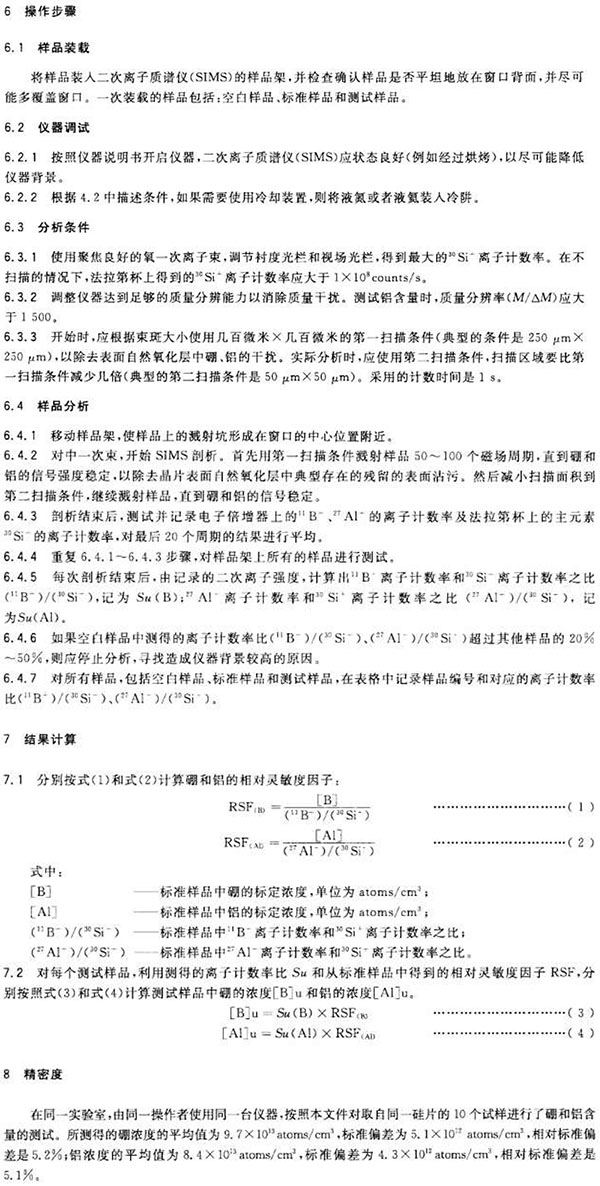1 Scope This standard specifies the method for the determination of boron and aluminum in silicon materials for photovoltaic cells using secondary ion mass spectrometry (SIMS). This standard applies to the quantitative analysis of the boron and aluminum contents of acceptor impurities in silicon materials for photovoltaic cells, in which the boron and aluminum concentrations are greater than 1×10 13 atoms/cm 3 . The measurement of other acceptor impurities may also refer to this standard. 2 method principle Under high vacuum conditions, the primary ion generated by the oxygen ion source undergoes acceleration, purification, and focusing, which bombards the surface of the sample, sputtering a variety of particles, and extracts ions (ie, secondary ions) from the ion source, which will be different through the mass spectrometer. The ions are separated from each other by the ratio of ions, and the secondary ion intensity ratios (B-)/(Si-), (Al-)/(Si-) of boron and aluminum in the sample and silicon are respectively recorded and calculated, and then the relative sensitivities thereof are used. Factor for quantification. 3 Interference factors 3.1 Boron and aluminium adsorbed on the sample surface interfere with the measurement of boron and aluminium in the sample. 3.2 Boron and aluminium absorbed from the sample chamber of the SIMS instrument to the sample surface interfere with the measurement of boron and aluminum in the sample. 3.3 The surface of the sample in the window of the sample holder should be flat to ensure that the inclination of the surface and the ion collection optical system does not change when each sample is moved to the analysis position, otherwise the accuracy and accuracy of the measurement will be reduced. 3.4 The accuracy and precision of the measurement are significantly reduced as the surface roughness of the sample increases, and can be eliminated by chemical mechanical polishing of the sample surface. 3.5 The uneven distribution of boron and aluminum in the standard sample will affect the measurement accuracy. 3.6 The deviation of the nominal boron and aluminum concentrations in the standard sample can cause deviations in the measurement results. 3.7 The detection limit may differ due to different instruments or different conditions of the same instrument. 3.8 Because secondary ion mass spectrometry is a destructive test, sampling should be performed and the sample taken should be representative of the nature of the batch of silicon material. This standard does not stipulate a uniform sampling method, because most suitable sampling plans differ depending on the sample conditions. For the purposes of arbitration, the sampling plan should be approved by the testing parties before testing. 4 Instruments and Equipment 4.1 sector magnetic field secondary ion mass spectrometer The instrument needs to be equipped with an oxygen primary ion source, an electron multiplier capable of detecting positive secondary ions, and a Faraday cup detector. The mass resolution should be better than 1500. 4.2 Liquid nitrogen or liquid helium cooling cryopanel If the analysis chamber vacuum is greater than 1.3 x 10-5 Pa, use a nitrogen or liquid helium cooled cryopanel around the sample holder in the analysis chamber. If the vacuum in the analysis chamber is less than 1.3 x 10-5 Pa, the above cooling is not required. 4.3 Test sample holder Make sure that the analysis surfaces of the various samples on the sample holder are in the same plane and perpendicular to the extraction electric field (about several kV, depending on the instrument model). 5 sample preparation 5.1 Standard samples A silicon single crystal standard sample co-doped or separately doped with boron and aluminum is required, and the body concentrations of boron and aluminum are determined by other measurement methods agreed by all parties, and the concentration is within the range of (1-10) 1015 atoms/cm3. The distribution uniformity is within 5%. The analysis surface of the standard sample should be chemically polished or a more effective chemical mechanical polishing to make it flat and smooth. 5.2 blank samples A silicon single crystal having a boron and aluminum concentration in a vacuum region of 1 x 1012 atoms/cm3 is required as a blank sample. The analysis surface of the blank sample should also be chemically polished or a better chemical mechanical polishing to make it flat and smooth. 5.3 Test samples The analysis surface of the test sample should also be subjected to chemical etching or a more effective chemical mechanical polishing to make it flat and smooth, and the sample size should fit within the sample holder. 9 Report At a minimum, the report should contain the following: a) Sample delivery unit and sample delivery date; b) sample name, specification and number; c) sample status description; d) sampling position; e) standard sample and blank sample information; f) the instrument model; g) measurement environment; h) measurement results, including compensation and relationship curves; i) Operator, measurement date, measurement unit.
We diviided the led light according to the using eviiroment. Most of our product is the commercial LED Lighting
Commercial lighting is a term used to describe lighting that is used in commercial spaces, including auto dealerships, distribution centers, churches, factories, offices, and warehouses. Unlike residential lighting, commercial lighting is made to withstand more abuse and has a longer lifespan.
While the focus of residential lighting is often on aesthetics, commercial lighting is task orientated. Commercial lighting systems are designed based on what the application is. For example, in an office-type setting, you may see task lighting, which illuminates specific areas where employees need concentrated light to be able to perform their jobs.
Magnetic Spotlight,Magnetic Track Spotlight,Magnetic Track Led Spotlight,Magnetic Double Head Light Jiangmen Dilin Lighting High-Tech Co., Ltd. , https://www.jmdilinlighting.com
Secondary Ion Mass Spectrometry of B and Al Acceptor Impurities in Silicon Materials for Photovoltaic Cells
